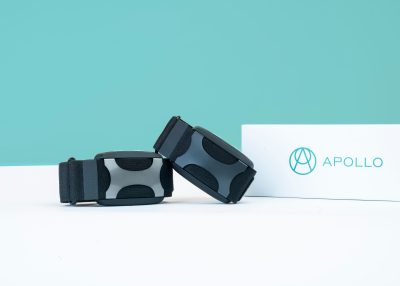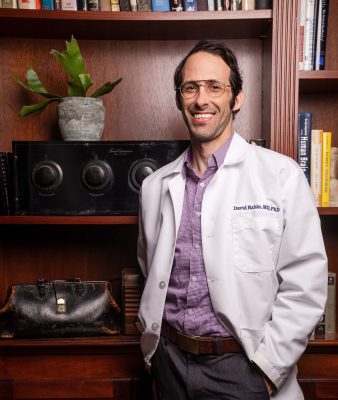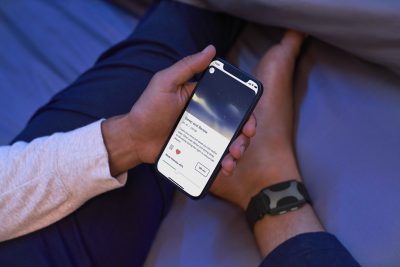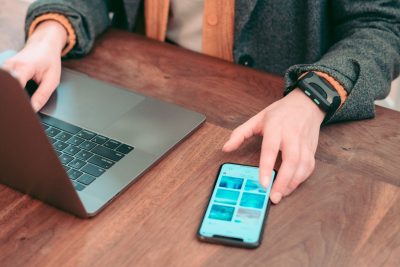
Most people are familiar with health and fitness trackers these days. Whether you are a dedicated Apple Watch wearer yourself or know someone who is all about their WHOOP Band, these kinds of wearable and app trackers are commonplace in society. But what about a wearable device that instead of tracking your health stats, it focuses on improving them?
Meet the Apollo. The Apollo is a device that can be worn on the wrist, ankle, or clipped to clothing. Created through thorough scientific research, it delivers gentle vibrations to the body for a soothing effect. The company describes it as a “wearable hug for your nervous system.”
To find out more about how this vibrating device actually works, we spoke to Dr. David Rabin, MD and PhD. Rabin is a psychiatrist and neuroscientist — and now also an entrepreneur. He is the creator of the Apollo, as well as the co-founder and chief innovation officer at Apollo Neuroscience.

The Inspiration Behind The Apollo
As a psychiatrist and psychotherapist, Rabin works with patients on recovering from a variety of mental health disorders, specializing in treatment of post-traumatic stress disorder (PTSD), depression, anxiety disorders, and substance use disorders. “Healing from mental illness, in general, is about learning new patterns of thinking and unlearning old patterns of thinking that aren’t serving us,” Rabin told Sleepopolis. “That requires the body to be in a fairly balanced, healthy state.”
However, achieving that balanced, healthy state is difficult for a patient already struggling with mental illness. When someone is under severe, chronic stress (as many people with PTSD, anxiety, or depression often are) the body “physiologically opposes learning new things, to the point where we run from newness,” Rabin said. “We actually fear it and new things become extremely challenging to master and learn.”
Rabin observed this problem among his own patients, as well as in literature from other doctors and clinicians. He began to wonder if it would be possible to give patients something that would help them calm their bodies and get to the state where they feel safe enough to learn. Then, theoretically, his patients would be primed to bring techniques like meditation, deep breathing, exercise and movement, or mindfulness into their recovery. Thus, the research to create the Apollo began.
Developing The Apollo
Rabin worked with Greg Siegle, PhD at the University of Pittsburgh’s Program in Cognitive Affective Neuroscience to develop and test the technology that eventually became the Apollo.
One of the first iterations of this device they tried used electricity to slightly shock people. While this method was similarly effective to the vibrations the Apollo currently uses, Rabin realized through the advice of his wife and co-founder Kathryn Fantauzzi that a device that shocks people with electricity would be a hard sell. “We didn’t believe that, we were the scientists being like, ‘This works. Let’s move this forward,’” Rabin said. But Fantauzzi was convinced people wouldn’t like the idea of the product, even if it was effective.
Fantauzzi, who was engaged to Rabin at the time and serving as his research team’s entrepreneurial advisor, ran a survey concluding that people did not want to be shocked with electricity, even if it would make them feel good. Rabin knew he wanted this device to have a widespread reach, so he took Fantauzzi’s advice and began exploring another way to achieve the same effects.
Taking inspiration from the way music can affect our energy levels and focus, they turned to sound and vibration for the next iteration of the device. “Then we started to realize that touch actually can do the same thing,” Rabin said. “So we explored that very, very carefully and thoroughly in the lab and realized that [touch] actually does do the same thing and doesn’t require your ears at all.”
Scientifically Testing The Apollo
The first study Rabin and Siegle performed to test the Apollo technology at the University of Pittsburgh was a double-blind, randomized, and placebo-controlled crossover study with 38 healthy subjects.
The study assessed how participants performed on the Paced Auditory Serial Addition Test (PASAT) with and without the Apollo, with placebo vibrations, and without vibrations. The PASAT is a written assessment of cognitive function that requires making quick calculations. This can be very frustrating to the test-taker, creating a situation in which participants would be stressed to test how 1) their accuracy on the test differed with Apollo vs placebo vs nothing 2) the participants’ reported feelings of stress in those three conditions and 3) their heart rate variability (HRV), which is a metric to measure stress.
When participants took the test with either a placebo vibration or no vibration, their accuracy decreased over time, they reported feeling stressed, and their HRV either did not change or decreased. With the Apollo, participants reported feeling calmer, their accuracy improved, and their HRV increased within three minutes. This study was published in 2018 in Biological Psychiatry, a peer-reviewed journal.
These results excited Rabin and Fantauzzi, who decided to take the idea and run with it, creating prototypes and distributing them to people to test in the “real world.”
Using The Apollo For Sleep

“We thought everybody was going to use it for focus and creativity and for doing things better when you’re awake, because that was what our studies showed us at that point,” Rabin told Sleepopolis of the release of the first Apollo prototypes. “And what we found out was that people did use it for that, but what they use it for the most is sleep.”
With real-world users self-reporting to the Apollo team that they primarily used the product to help them sleep — some even reporting reducing their use of substances to fall asleep — Rabin said they decided to shift their focus as a product to tackle sleep.
Sleep Allows Us To Recover
“Everything starts with sleep and ends with sleep,” Rabin told Sleepopolis. Sleep is when our bodies are able to recover and if we aren’t able to get enough sleep (or enough deep, restful sleep), “then we don’t consolidate memories effectively, which means that our short-term memory is not moving into long-term the way it should be,” Rabin said.
What’s the harm of memory not functioning properly? We’re not able to focus or pay attention as well, nor are we in the best state to learn new things and to safely question “old things that aren’t serving us,” Rabin said. And relevant to Rabin’s work as a psychiatrist and psychotherapist, a lack of sleep means a reduced capability to engage in therapy.
Working in a clinic, Rabin learned sleep was one of the number one things people with PTSD reported struggling with, because they don’t feel safe enough to allow themselves to go to bed. When a person suffers from nightmares or anxiety from the trauma they have experienced as they try to sleep, sleep itself becomes scary — even if there is no real threat. Rabin asked these patients, “What activates safety for you?” They answered with things like snuggling with a loved one or pet, soothing touch, and doing deep breathing exercises.
“All of these techniques activate the safety systems in our bodies that send a signal to our brain that says, ‘If I have the time to pay attention to this soothing safety feeling right now — the feeling that’s making me feel nice and safe — then I can’t possibly be running from a lion in this moment,” Rabin said.
This works, Rabin said, because we are evolved to survive. If there really was a physical threat, such as a lion to run from, our brain wouldn’t allow us to focus on something less important in that moment (such as our breath or a physical touch) because we would be too busy running from that lion.
Continued Research on the Apollo
While the Apollo wearable device is currently available for purchase, Rabin hasn’t stopped researching the technology. A number of studies are displayed on Apollo’s website, the largest of which is a study carried out by the Apollo team on 582 Apollo wearable users who shared their sleep data via Oura Ring sleep trackers. This study is still ongoing (and you can actually join it if you own an Oura Ring), but the Apollo team has published some preliminary results suggesting that the Apollo leads to an increase in deep sleep, REM sleep, total sleep time, and heart rate variability, as well as a decrease in resting heart rate.
Rabin is excited for the future of wearable technology that the Apollo represents. While the current market of wearable technology is primarily fitness and sleep trackers, he thinks the next generation will be “wearable digital therapeutics.” These types of devices, including the Apollo, won’t just track information and tell you to make a change, Rabin said. “They actually make the change for you.”
Would You Try The Apollo Neuro?

If your interest is piqued, you can head over to the Apollo Neuro website to learn more about the device and Rabin’s research, as well as to purchase your own Apollo Neuro wearable device — currently available for $399. The Apollo wearable is a small device that can either be clipped to the wearer’s clothing or worn on a band around the wrist or ankle. It’s available in three different band sizes and in six different colors.
For a first-hand account, take a look at our Apollo Wearable review from Sleepopolis Senior Editor Bridget Chapman.